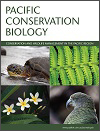PC24081Restoration thinning has minor and temporary effects on understorey fuels in a regrowth eucalypt floodplain forest under conservation management
Thinning is sometimes used to reduce fire risks during forest restoration but its efficacy in Australian eucalypt forests is uncertain. We undertook experimental thinning in a previously logged river red gum forest. We found that regrowth tree density did not substantially affect understorey fuels and thinning did not change fuel hazard ratings. Thus, thinning did not reduce or increase fire risk during the study.
PC24081 Abstract | PC24081 Full Text | PC24081PDF (947 KB) | PC24081Supplementary Material (5.6 MB) Open Access Article







